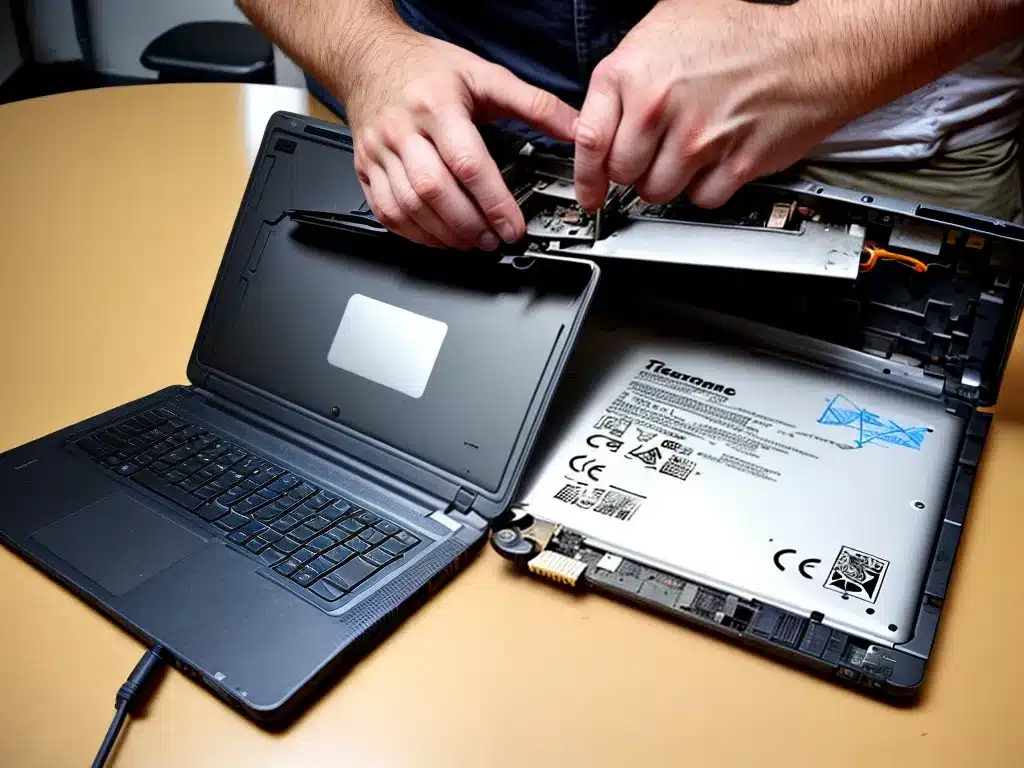
Why Laptop Batteries Die
All laptop batteries eventually lose their ability to hold a charge. There are a few main reasons why laptop batteries die:
Old Age
Most laptop batteries last 2-3 years before needing to be replaced. The chemicals inside the battery simply degrade over time, even if the laptop is rarely used.
Overcharging
Leaving a laptop plugged in all the time, especially when fully charged, can degrade the battery faster. The battery overheats and the chemicals break down more rapidly.
Extreme Temperatures
Exposing a laptop battery to very hot or very cold temperatures reduces its lifespan. Don’t leave your laptop in a hot car or freezer.
Improper Care
Not fully charging and discharging the battery periodically can increase the rate of chemical degradation inside the battery.
When to Replace a Laptop Battery
Here are some signs it’s time to replace your laptop’s battery:
- Your laptop shuts down abruptly even when plugged in
- You get a “consider replacing your battery” warning
- Runtime is much shorter than when new, even when fully charged
- The battery won’t charge fully or takes much longer to charge
Replacing the battery as soon as these issues arise can help avoid further damage to your laptop. A worn out battery can no longer provide stable power.
How to Choose a Replacement Laptop Battery
When buying a new laptop battery, make sure to get the right type:
-
OEM or third-party? OEM (original equipment manufacturer) batteries are made by the laptop brand and typically higher quality. Third-party batteries are cheaper but may not last as long.
-
Voltage and amperage. Match the voltage (V) and amperage (Ah) ratings of your old battery. This info is often printed on the battery.
-
Connector type. Ensure the replacement battery’s connector matches your laptop’s. Newer laptops use internal batteries instead of removable ones.
-
Dimensions. The new battery should fit the battery compartment without issue. Measure your old battery if unsure.
Checking the make, model, and part number of your laptop can help you find a compatible replacement battery easier. Avoid batteries that don’t specifically say they work with your laptop model.
How to Replace a Removable Laptop Battery
If your laptop has a removable battery, follow these steps:
-
Shut down the laptop and unplug the AC adapter.
-
Locate the battery release latch. This is typically a sliding switch or button on the bottom of the laptop.
-
Slide the release latch to detach the old battery from the laptop. Lift it out of the compartment.
-
Insert the new battery into the empty compartment, making sure the connectors align.
-
Push the battery into place until it clicks and secure the release latch.
-
Plug in the AC adapter and turn on your laptop.
-
Fully charge and calibrate the new battery for optimal performance.
How to Replace an Internal Laptop Battery
For newer laptops with sealed internal batteries:
-
Shut down and unplug the laptop. Remove any screws securing the bottom panel.
-
Pry up the bottom panel carefully with a plastic prying tool. Set it aside.
-
Disconnect the battery cable from the motherboard. Remove any screws or adhesive securing the battery.
-
Lift out the old battery and disconnect it from the motherboard cable.
-
Connect the motherboard cable to the new battery. Secure it in place with screws or adhesive.
-
Replace the bottom panel and any screws. Plug in the AC adapter.
-
Power on the laptop and let the new battery fully charge.
Replacing an internal laptop battery is trickier. Consider having a computer technician do it if you’re unsure.
Disposing of Old Laptop Batteries
Don’t throw dead lithium-ion batteries in the trash. Take them to a battery recycling center so they can be disposed of properly and safely. Many stores recycle old batteries for free. You can also contact your local waste management authority for disposal guidelines.
Replacing a dead laptop battery restores usability and mobility to your computer. With some diligence, you can find the right replacement battery for your make and model. Follow all safety precautions when removing internal components.












